CBA: Huge fiscal stimulus props up household income
by Leith van OnselenGareth Aird, head of Australian economics at CBA, has published research on the extent to which household impacts have been supported by the federal government’s stimulus:
Key Points
• Growth in government benefit payments has accelerated due to both the number of people receiving JobSeeker as well as the doubling in the fortnightly JobSeeker payment.
• Growth in government benefits paid plus wages and salaries paid sits comfortably above pre-COVID-19 levels.
• The state of the economy when the fiscal stimulus fades in late-September/October, as well as any changes in policy related to JobKeeper and JobSeeker, will be critical to the outlook for household income.
Overview
Updated analysis from payments into CBA bank accounts indicates that the reduction in household income from job losses to date continues to be more than offset by an increase in government benefit payments. The annual growth rate in our partial read on household income that comprises wages and salaries paid plus government benefits paid has accelerated over the past two weeks (latest data to 22 May).
Whilst week to week the data is volatile, the trend is clear. Growth in government benefits paid plus wages and salaries paid sits comfortably above pre-COVID-19 levels. The big contraction in spending over Q2 20 so far sits completely at odds with the dynamics at play on the income side. Fiscal stimulus reconciles the difference.
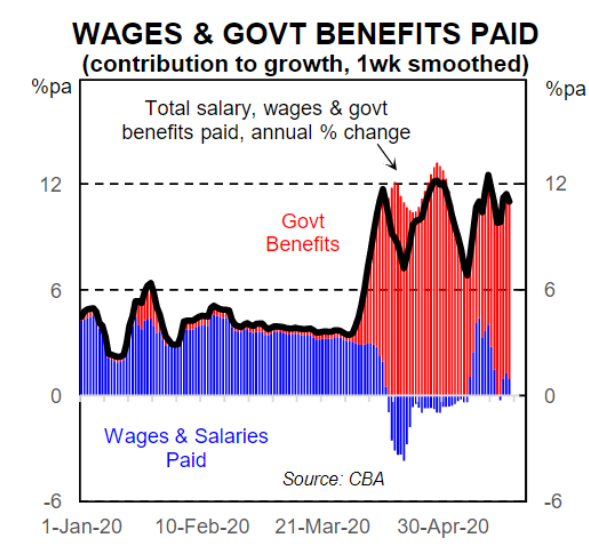
The reality is that fiscal stimulus can plug the income gap, but it cannot plug the spending gap if many businesses and activities remain shut. Our data on spending and income indicates that savings will rise significantly over Q2 20 which points to upside risk for domestic household consumption over Q3 20 as the economy is re-opened. The key uncertainty now is around the state of things in late-September/October.
Government benefits paid
Growth in government benefits paid into CBA bank accounts has accelerated over the past few weeks. The reason is JobSeeker. The number of CBA bank accounts receiving JobSeeker has roughly doubled since mid-March. But the amount paid into CBA bank accounts has risen more than three-fold. The reason that growth in dollars paid has risen by so much more that the number of people receiving JobSeeker is that payments have been doubled. This has an impact not only on people who have recently lost their job and gone onto JobSeeker, but it also impacts the people who were on JobSeeker pre-COVID-19 pandemic. These people have effectively had a doubling in their income. Based on our data, growth in government benefits paid was running a little over 50%/yr at 22 May. Note that this does not include JobKeeper (see below).
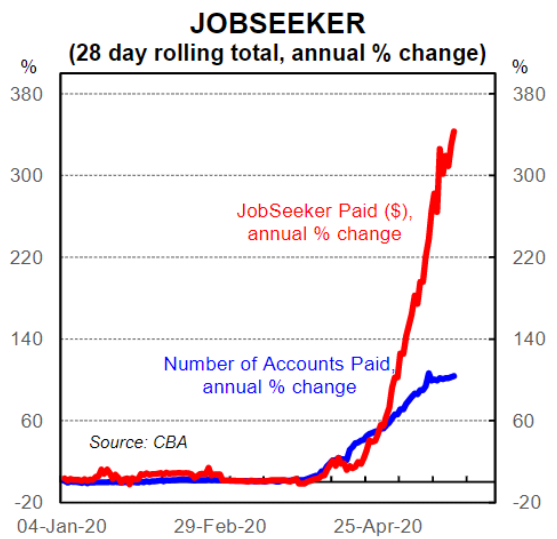
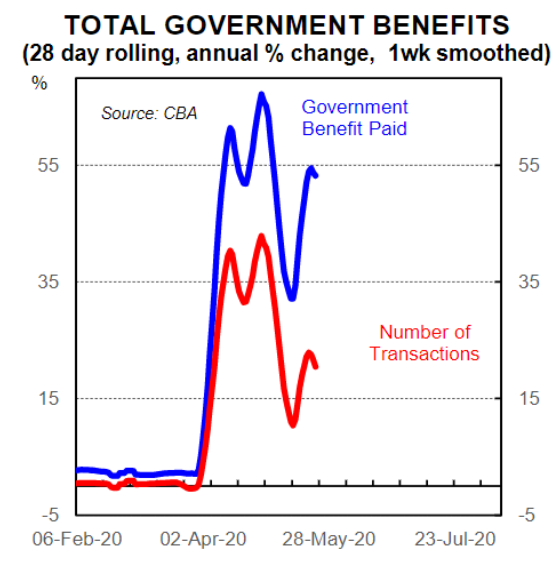
Wages and salaries paid
Our wages and salaries data captures all wages and salaries paid into CBA bank accounts. In essence it is picking up changes in the level of employment, wages growth and hours worked. It includes JobKeeper, however we are unable to quantify the amount of JobKeeper within wages and salaries. JobKeeper payments from the ATO to employers only started on 7 May 2020 but employers should have been paying it to employees through April (i.e. the ATO is paying employers ~one month in arrears).
Last Friday the Government announced some significant news with regards to the JobKeeper program. The Government now expects the number of employees likely to be covered under the JobKeeper program to be around 3.5 million versus their initial estimate of around 6.5 million workers. This means that the estimated cost of JobKeeper falls from $A130bn to $A70bn. It means that within our wages and salaries data there is significantly less JobKeeper dollars being paid than previously thought.
Our wages and salaries data indicates that there was a little spike in wages and salaries paid over mid-May. But it looks like statistical noise. The spike occurred essentially one month after the plunge in mid-April so it’s a base effect more than anything else. What matters is the overall picture and that suggests a modest pickup in wages and salaries paid in recent weeks. That makes sense given hours worked should increase a little over the second half of May relative to April as some parts of the economy have been reopened. We will be watching the data very closely from here for any signs of a further lift.
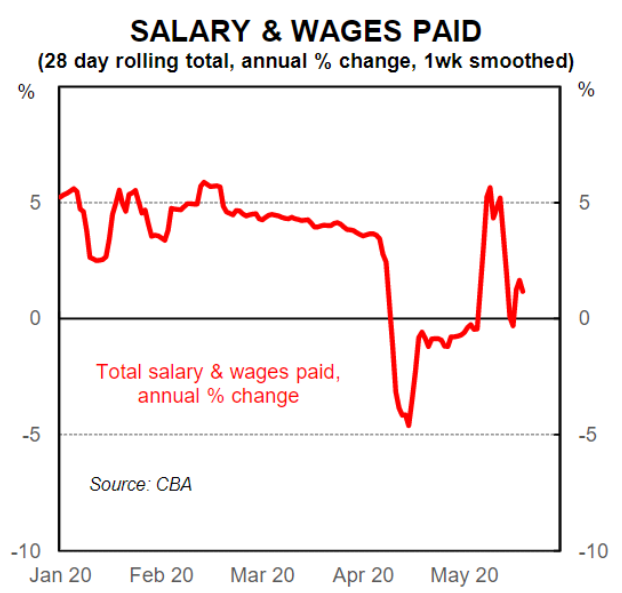
Our partial read on household income
Combining wages and salaries paid into CBA bank accounts with government benefits paid gives us a partial read on household income (it excludes rents, interest earned, dividends and a few other things). Our data indicates that on this measure alone the increase in government benefits over the past few weeks coupled with a modest rise in wages and salaries paid has seen household income accelerate. It leaves us very comfortable with our view that real household disposable income will not print anything like the 8%/yr contraction in Q2 20 that the RBA has forecast.
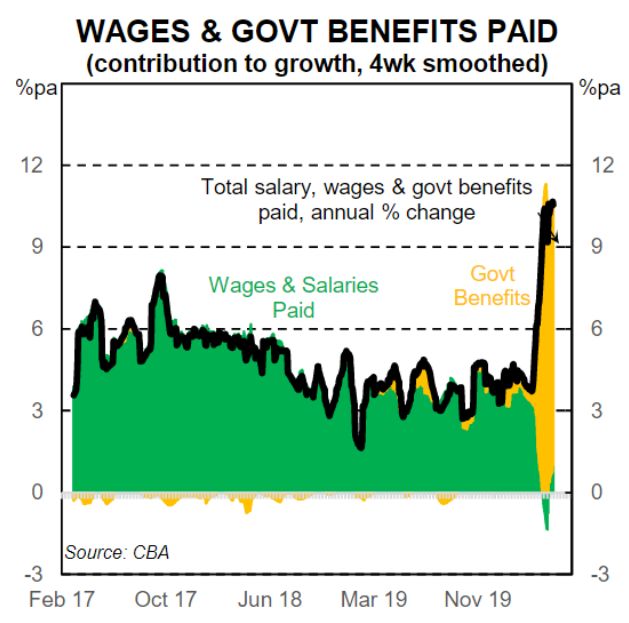
The size of the fiscal stimulus means that household income should remain in good shape until late-September / October. The key question then is around what happens to income when JobKeeper comes to an end and the JobSeeker payment is due to return to itspre-COVID-19 level.
It is very hard to answer this at the moment as a lot will depend on the strength of the economy by October, how many people remain unemployed and how many people who were receiving JobKeeper are no longer required by their employer (these people will move from being considered employed to unemployed). In addition, the outlook for household income over Q4 20 will be heavily depend on whether the Government changes its stance on JobKeeper or more likely JobSeeker.
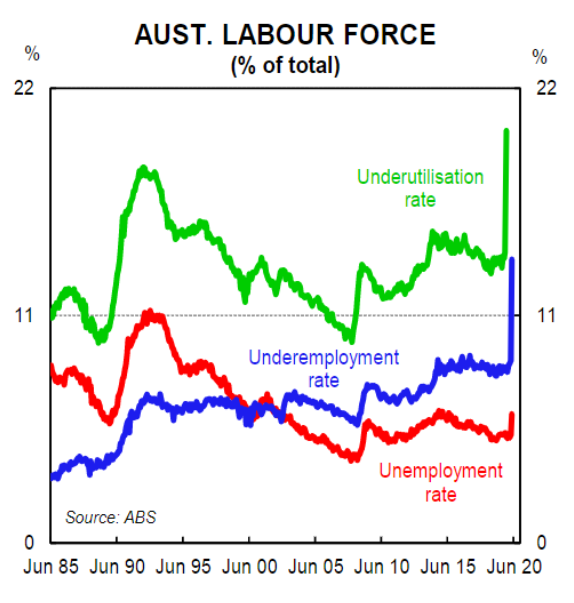
As we noted earlier in the week, the Government now has some flexibility around unwinding the COVID-19 induced fiscal stimulus due to the estimated cost of JobKeeper falling from $A130bn to $A70bn. It may be that the Government now takes a ‘taper-type’ approach to winding back the stimulus, in which case the negative shock to household income in Q4 20 would be smaller.
We should remind ourselves that the fiscal stimulus is borrowed money. For the long term health of the economy it is necessary that we are on a path towards full employment as soon as possible and that the journey is not a long one. Income that improves living standards in the long run comes from production, not debt financed transfer payments. Fiscal stimulus that is borrowed money delivered to the household sector can only minimise the economic pain in the short run. It is not a solution that delivers prosperity in the medium to longer term. A brief look at history reminds us of this.

Leith van Onselen
Leith van Onselen is Chief Economist at the MB Fund and MB Super. Leith has previously worked at the Australian Treasury, Victorian Treasury and Goldman Sachs.

Latest posts by Leith van Onselen (see all)
- Carmageddon awaits unless work from home continues - May 29, 2020
- Mortgage repayment cliff beckons - May 29, 2020
- ANU: Job and income losses halted, confidence rising - May 29, 2020